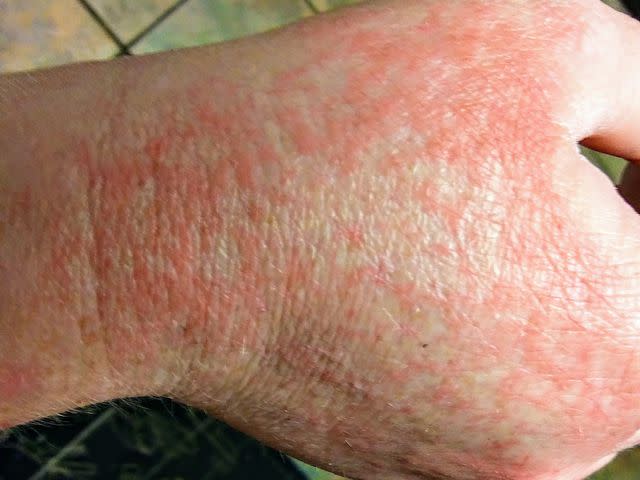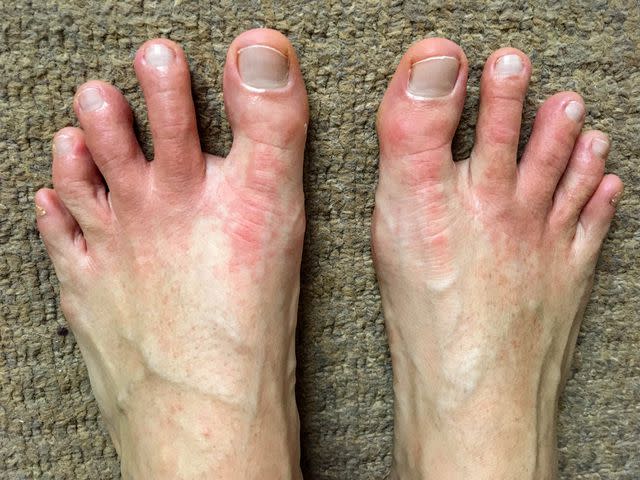COVID Rash: Explaining Short- and Long-Term Symptoms
Medically reviewed by Sameena Zahoor, MD
A COVID-19 rash is one of the many symptoms of COVID-19 that can occur in children or adults. It is caused by an overactive immune response that results in inflammation and discoloration, typically in the toes (though a COVID-19 rash can also appear on fingers, the chest, or the trunk).
This article discusses some of the features of these rashes, how soon after an infection, a rash might appear, and whether a COVID-19 rash is a symptom to worry about.

Reproduced with permission from © DermNet dermnetnz.org 2023.
Rash and COVID-19: What’s the Link?
The virus that causes COVID-19 (SARS-CoV-2) has evolved several times, and each variant has a different set of symptoms.
One consistency across the different forms of this viral infection is how it triggers an inflammatory response in the body. The general thought is that rashes that appear during a COVID-19 infection are either the result of the virus's direct interaction with skin cells or an extreme immune system reaction to the viral infection.

Reproduced with permission from © DermNet dermnetnz.org 2023.
Symptoms to Look For
Rashes that appear with a COVID-19 infection can take many forms. The type of rash can vary by the strain of the virus and the stage of your infection.
Symptoms of COVID-19 rashes can include:
Discolored areas that are flat or slightly raised (maculopapular rash)
Raised, fluid-filled blisters (papulovesicular rash)
Generalized or widespread discoloration (erythematous rash)
Discolored, itchy rash (urticarial rash)
Darkened areas of skin, especially on the toes or fingers ("COVID toes")
Missed Symptoms: Darker Skin Tones
COVID-19 rashes often go unnoticed in darker skin tones, as the natural skin pigment can camouflage signs of inflammation or irritation.
Maculopapular and papulovesicular rashes are among the most common manifestations of a COVID-19 infection. About one-third of all cases report both, making it difficult to differentiate between them.
There is also some variation as to when and where these rashes appear. Some people experience more skin symptoms on the toes and fingers, while other COVID-19 rashes are more prominent on the chest or trunk.
Finally, some researchers debate what a rash means for the severity and duration of a COVID-19 infection. One study describes maculopapular rashes developing later in a COVID-19 infection. In contrast, papulovesicular rashes more often appear at the start of the infection and before other symptoms. In some cases, a rash is the only symptom of a COVID-19 infection.
Symptoms Differences in Children vs. Adults
Some rash forms are more common in younger people and children. Rashes are also associated with severe inflammation in some kids infected with the virus. Multisystem inflammatory system in children (MIS-C) is a condition in which severe inflammation can lead to serious illness and even death.
How to Treat a COVID-Related Rash
Healthcare providers cannot treat a rash that occurs alongside a COVID-19 infection. A COVID-19 infection is treated by managing symptoms like fever and cough, but no cure exists for the virus.
Likewise, rashes caused by the coronavirus have no cure but are managed with medications and therapies to increase comfort. Healthcare providers typically recommend or prescribe antihistamines and corticosteroids for rashes, as they can reduce inflammation and reduce symptoms like itching.
Rash Risk for Immunocompromised Teens and Adults
People with weakened immune systems are vulnerable to infection. While mortality rates among immunocompromised people have decreased with the use of vaccines, symptoms like rashes can last longer for these individuals.
Complications of Untreated Rash From COVID-19
COVID-19 rashes can disappear in days or last several weeks. In most cases, the rashes will resolve without ongoing symptoms or complications. For some, a rash can be a sign of a more severe COVID-19 infection that could lead to long-lasting symptoms or complications.
While long-lasting effects of these rashes are possible, the symptoms are usually limited to changes in skin color (hyperpigmentation). In rare cases, permanent tissue damage or even tissue death (necrosis) may occur.
Limiting Infection and Secondary Risks
The most effective way to prevent a COVID-19-related skin rash is to avoid an initial COVID-19 infection.
Experts suggest taking the following steps to protect yourself and others from COVID-19:
Stay up-to-date on COVID-19 vaccinations and boosters.
Avoid going out in public if you are sick.
Try to avoid close contact with people you know are sick.
Wash your hands often.
Summary
Rashes are a possible symptom of a COVID-19 infection. The location and appearance of these rashes can vary from person to person and by variant.
If you develop a rash without other symptoms after exposure to the COVID-19 virus, you may want to be tested for COVID-19 to avoid spreading the infection to others. You may also develop a rash long after other symptoms of COVID-19 appear.
Antihistamines and steroids may help relieve symptoms like inflammation and itching that accompany these rashes. For most people, COVID-19 rashes clear in weeks without serious complications.
Read the original article on Verywell Health.

